Information
Significant achievements from the excavation of No. 2 Mound of Batatai cemetery, Yunnan
Summary: From July 2015 to June 2016, excavations of No. 2 Mound in Batatai cemetery in Qilin District, Qujing City, Yunnan Province were conducted again jointly by Yunnan Provincial Institute of Cultural Relics and Archaeology, Qujing Cultural Relics Administrati
From July 2015 to June 2016, excavations of No. 2 Mound in Batatai cemetery in Qilin District, Qujing City, Yunnan Province were conducted again jointly by Yunnan Provincial Institute of Cultural Relics and Archaeology, Qujing Cultural Relics Administration Office and etc. This excavation uncovered 490 square meters, including 343 tombs and more than 500 pieces (sets) of all kinds of funeral gifts. Besides, 38 activity floors of funeral ritual activities and other activity surfaces and 1 sacrificial pit as well as multi-levels slope-protecting accumulation in the southern area of the cemetery were exposed and cleared.
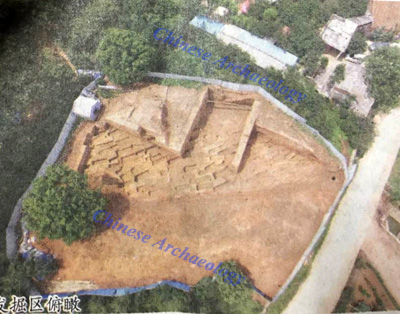
Aerial photo of excavation aera
Batatai cemetery was a mound formed by groups (sets) of tombs buried layer by layer from up to the bottom. In the bottom, tombs were placed most intensively. According to the excavation, tombs of Batatai cemetery could be preliminarily divided into three periods, early, middle and late periods. During early and middle periods, tombs were usually northeast-southwest orientation; while in the late period, most tombs were southeast-northwest orientation. The forms of tombs can be divided into two kinds, tombs with earth mound and tombs without earth mound. Earthen-mounds were usually oval in plane. And tombs with earthen mound were popular in the early and middle periods. In the late period, there were all earthen shaft pit tombs. Tomb pits were usually rectangular, only a few have trapezoidal planes.
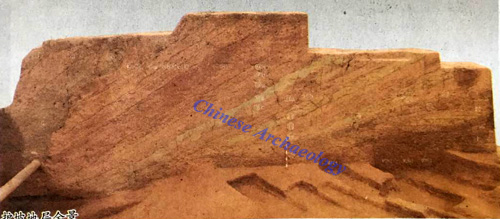
The multi-levels slope-protecting accumulation
During early and middle periods, there was mostly activity floor caused by funeral ritual activities around a single tomb. It had intensive soil including plenty charcoal and burned ash, which is more than 3~5 cm thick.
No large-scale tomb found during this excavation. Most of them were small-scale tombs. According to the funeral practices, tombs can be divided into single burial, double burials and burial with three people and so on. All skeletons of tomb owners were rotten, only a few tombs had some skeleton mark residue. According to bone mark, most of them were extended supine position burial. On the bottom of most tombs, there were ash traces of rectangular wood boards, which were predicted to be wooden coffin. Therefore, tombs of early periods might only have a piece of wood board as a funeral utensil.
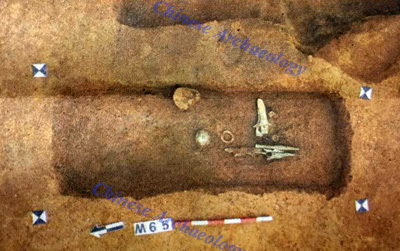
Tomb M65
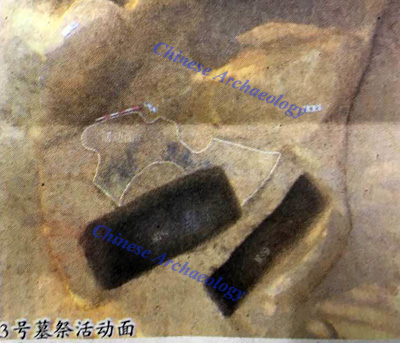
The activity floor caused by funeral ritual activities in tomb M3
In the early period, there were relatively few funeral gifts in the tombs, most of which were one or two pieces of bronze or jade artifacts. Most had no burial goods at all. In the middle period, the quantity of burial goods was increased. And in the late period, the funeral gifts are the richest. Among them, potteries were usually placed at the feet or on both sides of lower limbs of tomb owners. Bronze weapons were usually placed on both sides of their chests and waists. Accessories like jade and so on were mostly remained in the original position where they were worn on.
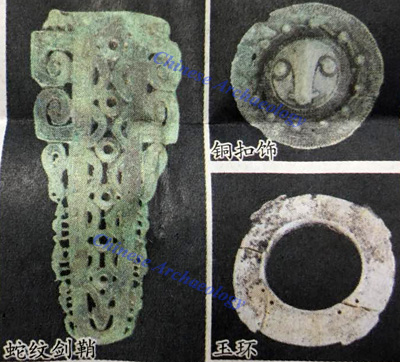
Cultural relics such as bronze buckle, jade ring unearthed from the site
The burial gifts bear distinctly local characteristics. Based on the raw materials, there were pottery, bronze artifacts, copper-iron alloying artifacts, jade and stone artifacts, agate artifacts, turquoise and so on. The shapes of pottery including Ding-tripod, jars, plates, lids, Dou-serving vessels, Hu pots and etc., among them, Ding-tripod, jars and plates were relatively ordinary and basic elements of the assemblage. Bronze and copper-iron artifacts including weapons, production tools, accessories and so on. Weapons contained Ge-daggers, spears, swords, pi-spears, arrowheads, pieces of armor and etc. Production tools include chisels, axes, shaves and so on. Accessories ranged from circular buckles, square buckles, nail-shaped round decoration, tube and flake-shaped accessories and bracelets and so on. Jade and stone artifacts have rings, jue-earrings, bracelets, tube, beads, pendants and etc. as well as a few agate beads.
Academic significances
Batatai cemetery was a very important cemetery in eastern Yunnan area from Warring states Period to Han Dynasty in terms of its wide distribution, relatively well preservation state as well as special funeral form. According to the excavation, main achievements include following aspects:
No. 2 Mound was the largest tribe communal cemetery with earthen mound, which was repeatedly used for a long time and distributed intensively with quite complex overlapping and breaking relationships between burials. This excavation clarified questions such as burial custom and burial system. Considering cultural characteristics of tombs, the unique burial custom that Batatai cemetery was different from other cemeteries was building earthen mound on the grave to reinforce.
The slope-protecting accumulation of the southern part of No. 2 Mound in Babatai cemetery is the unique reinforcement measure found so far in Bronze age cemeteries in Yunnan Province, which could provide us vital important evidences for our efficient understanding and depicting reasons of formation processes of No. 2 Mound.
Compared with excavated materials and other materials around Qilin District, it’s predicted that the earliest date of the cemetery could be the period of Warrior States Period and the latest date could be the beginning of East Han Dynasty. Besides, absolute date of the cemetery still need results of relative dating tests of specimen in future.
Batatai cemetery is of very distinctly local characteristics and the achievements from the excavation plays a very important role in academic research on local bronze cultures in the areas of the eastern part of Yunnan Province and the western part of Guizhou Province. Meanwhile, this will also provide significant materials for us to better understand development and evolution of forms of tombs and burial custom of local ancient people and will prompt us to re-evaluate many previous understandings. (Translator: Ma Huanhuan)

Aerial photo of excavation aera
Batatai cemetery was a mound formed by groups (sets) of tombs buried layer by layer from up to the bottom. In the bottom, tombs were placed most intensively. According to the excavation, tombs of Batatai cemetery could be preliminarily divided into three periods, early, middle and late periods. During early and middle periods, tombs were usually northeast-southwest orientation; while in the late period, most tombs were southeast-northwest orientation. The forms of tombs can be divided into two kinds, tombs with earth mound and tombs without earth mound. Earthen-mounds were usually oval in plane. And tombs with earthen mound were popular in the early and middle periods. In the late period, there were all earthen shaft pit tombs. Tomb pits were usually rectangular, only a few have trapezoidal planes.

The multi-levels slope-protecting accumulation
During early and middle periods, there was mostly activity floor caused by funeral ritual activities around a single tomb. It had intensive soil including plenty charcoal and burned ash, which is more than 3~5 cm thick.
No large-scale tomb found during this excavation. Most of them were small-scale tombs. According to the funeral practices, tombs can be divided into single burial, double burials and burial with three people and so on. All skeletons of tomb owners were rotten, only a few tombs had some skeleton mark residue. According to bone mark, most of them were extended supine position burial. On the bottom of most tombs, there were ash traces of rectangular wood boards, which were predicted to be wooden coffin. Therefore, tombs of early periods might only have a piece of wood board as a funeral utensil.

Tomb M65

The activity floor caused by funeral ritual activities in tomb M3

Cultural relics such as bronze buckle, jade ring unearthed from the site
The burial gifts bear distinctly local characteristics. Based on the raw materials, there were pottery, bronze artifacts, copper-iron alloying artifacts, jade and stone artifacts, agate artifacts, turquoise and so on. The shapes of pottery including Ding-tripod, jars, plates, lids, Dou-serving vessels, Hu pots and etc., among them, Ding-tripod, jars and plates were relatively ordinary and basic elements of the assemblage. Bronze and copper-iron artifacts including weapons, production tools, accessories and so on. Weapons contained Ge-daggers, spears, swords, pi-spears, arrowheads, pieces of armor and etc. Production tools include chisels, axes, shaves and so on. Accessories ranged from circular buckles, square buckles, nail-shaped round decoration, tube and flake-shaped accessories and bracelets and so on. Jade and stone artifacts have rings, jue-earrings, bracelets, tube, beads, pendants and etc. as well as a few agate beads.
Academic significances
Batatai cemetery was a very important cemetery in eastern Yunnan area from Warring states Period to Han Dynasty in terms of its wide distribution, relatively well preservation state as well as special funeral form. According to the excavation, main achievements include following aspects:
No. 2 Mound was the largest tribe communal cemetery with earthen mound, which was repeatedly used for a long time and distributed intensively with quite complex overlapping and breaking relationships between burials. This excavation clarified questions such as burial custom and burial system. Considering cultural characteristics of tombs, the unique burial custom that Batatai cemetery was different from other cemeteries was building earthen mound on the grave to reinforce.
The slope-protecting accumulation of the southern part of No. 2 Mound in Babatai cemetery is the unique reinforcement measure found so far in Bronze age cemeteries in Yunnan Province, which could provide us vital important evidences for our efficient understanding and depicting reasons of formation processes of No. 2 Mound.
Compared with excavated materials and other materials around Qilin District, it’s predicted that the earliest date of the cemetery could be the period of Warrior States Period and the latest date could be the beginning of East Han Dynasty. Besides, absolute date of the cemetery still need results of relative dating tests of specimen in future.
Batatai cemetery is of very distinctly local characteristics and the achievements from the excavation plays a very important role in academic research on local bronze cultures in the areas of the eastern part of Yunnan Province and the western part of Guizhou Province. Meanwhile, this will also provide significant materials for us to better understand development and evolution of forms of tombs and burial custom of local ancient people and will prompt us to re-evaluate many previous understandings. (Translator: Ma Huanhuan)
Category: English
News
Information
Key words:
